Kenyan Emerges to Set Grandma’s Record
Filed under: Sports
By John Gilbert
Dominic Ondoro was confident even back in the fog halfway through his first Grandma’s Marathon. Even then he was leading a swift pack of 11 East African runners that emerged almost mystically from the foggy North Shore and then disappeared again.
They were running at a pace that put them in reach of Dick Beardsley’s 33-year-old record time, but after consistently turning sub-5-minute miles, reaching the halfway point in 1:04:46, Ondoro and the group slowed down measurably, and it appeared once again the magical record would stand. It turned out to be a strategic move by Ondoro, who, wearing bib No. 1 and running easily in front, decided to slow down, just to see if he might coax one of his competitors to show his hand and make a break for the lead. Instead, the pack slowed down, too.
When the group slowed, did Ondoro think that he could still break the record? “Yes,” he said softly, after shattering the record with a 2 hour, 9 minute, 6 second performance.
With about seven miles to go, Ondoro took off like a Formula 1 race car whose driver just realized he had neglected to engage top gear. He pulled ahead, then pulled ahead more. Usually, when someone breaks from a group running that close together, at least a couple others stay reasonably close. Not this time.
When he ran up Lemon Drop Hill and sailed away down London Road, Ondoro got to the brick-covered area of Superior Street, at 5th Ave. E., he was running alone. There were the pace and media cars ahead of the field, and then one lone runner. When he disappeared onto West Superior Street, a look back to the east revealed nobody.
“I knew what the record was, and halfway through, I knew I could break the record,” Ondoro said. “I doubled my speed and nobody came with me.”
Beardsley, riding in his now-customary spot in one of the pace cars just ahead of the field, said someone called out to him: “Your record’s safe for another year.”
“Not the way he’s running,” Beardsley yelled back.
“I’ve never seen a nicer, smoother-looking runner,” Beardsley said afterward. “When they got to the 19.5 mile mark, there were still eight of them running together. But when he put the hammer down, nobody kept up with him. He looked back once, to see if anybody was close. Nobody was there. And he was running 2:29.5 miles there near the end.”
Ondoro is 26, which means he was seven years from being born in Eldoret, Kenya, when the greatest race in Grandma’s Marathon’s history was run, back in the event’s infancy. It was 1981, and defending Grandma’s champion Garry Bjorklund pushed Dick Beardsley to the limit before Beardsley persevered and covered the distance in 2 hours, 9 minutes, 37 seconds, blistering the 26.2-mile marathon from Two Harbors to Canal Park.
The record he broke had been set in 1980, one year before, by Bjorklund, whose winning time remained the event’s second-swiftest until Saturday. And Bjorklund’s second-best time behind Beardsley in 1981 was still the eighth best. Since then, for 32 consecutive years, several hundred of the best runners in the world have come to Duluth, filled with hope of breaking that record, only to leave with that stubborn 2:09:37 standard still standing.
But Dominic Ondoro came to the North Shore on Saturday, June 21, 2014 as a tall, lean man on a mission, and when he made his lengthy finishing surge, he reduced 10 strong competitors to an East African supporting cast. So dominant was Ondoro’s 2:09:06 time that when Betram Keter beat former Grandma’s winner Christopher Kipyego to the Canal Park finish line by a second to capture second place, they were almost three full minutes behind, at 2:11:58.
The straight chute ending with the abrupt rise at Lemon Drop Hill, which has undone so many worthy challengers over the years, was a speed bump to Ondoro. “I’m used to hills,” he said. “That’s the way I’m training. Eldoret is very hilly, in the mountains, so I’m used to this.”
Eldoret is a small village, and Ondoro and his family lived about two miles out of town, he estimated. He has run all his life, as a way of life, in Kenya. He had only run marathons for four years, but he has established his preference for running swiftly. In a little over a year, Ondoro won at Melbourne, Australia, with a 2:10.17 time, and he won last year at Tiberias, Israel, in an eye-popping 2:08.0.
“I liked the course,” Ondoro said. “I liked the fog, too. When I won at Melbourne, it was foggy like this.”
Beardsley Yields Record, but Can’t Erase Memory
Dick Beardsley was quick to give Dominic Ondoro a congratulatory hug for breaking his record and winning the 38th Grandma’s Marathon, but there is no doubt that Beardsley’s amazing record run in 1981 will remain an iconic part of Grandma’s history.
Beardsley remembers details of that race as if they happened yesterday, instead of 33 years ago. And he was amazed when told that the track public address announcer proclaimed that the greatest thing about Beardsley’s victory was that “he did it all himself. He had nobody to help him.”
“Are you kidding?” Beardsley said, incredulously. “Garry Bjorklund pushed me all the way in that race, and there’s no way I would have set the record if he hadn’t.”
Garry Bjorklund from Twig was a local legend for his track and cross country running at Proctor High School and the University of Minnesota. Championship runners have a small window of opportunity to reach a true peak, and Bjorklund may have done it in 1979 and 1980, when he went to Boulder, Colo., to overload train in the high altitude for the 1980 Summer Olympics in Moscow. There are many, myself included, who believe that Bjorklund might have won the Olympic marathon in 1980, but that was the year that President Jimmy Carter, upset that the Soviet Union had invaded Afghanistan, decided to turn sports into the ultimate political gambit and forced the U.S. to bypass — boycott — the Moscow Olympics.
Bjorklund had to be torn up by the decision, because four years hence he would be past his prime. He came home to Duluth in June of 1980 and blistered the Grandma’s Marathon course to win in 2:10:20.
“I ran the 1980 Olympic trials, and Garry didn’t even run them,” Beardsley recalled. “He went to Duluth instead and ran a 2:10:20, and he did that all by himself.”
Beardsley also recalled that Bjorklund came back a bit out of shape to run the 1981 Grandma’s. “I had run a 2:08 at the Boston Marathon and finished second to Alberto Salazar in a race that came down to a 200-meter sprint,” Beardsley said. “At Grandma’s, there was one guy, one of the best, in Garry, the defending champion. A half-mile into the race, BJ — we all called Garry BJ — said to me, ‘I’m here for you, and I’ll help you any way I can, but it’s your race.’
“We stayed together all the way in, and just before the Lester River Bridge, I glanced back to see if anybody was coming, and when I turned back, Garry had made a surge, and got maybe 30 or 40 meters ahead of me. I kinda panicked. I caught up to him at about the 19-mile mark, and once I caught up to him, I figured I’ve got to make a statement, so I made a surge and put Garry about 10 meters back. A guy on a bike told me I had done a 4:42 mile, so I put on another surge and did a 4:36.
“That time, I could tell that BJ was hurting, but I though I was going to have a heart attack! I got to the top of Lemon Drop Hill, and glanced at my watch — but the battery had died. I had gotten a real bad side ache — a stitch in my right side — and I was praying the finish would come soon.
“When I got close to the Radisson, where we turn down off Superior Street onto 5th Avenue West, all of a sudden I see a little kid, right in the middle of the street, playing with a Tonka Toy truck. When I got to within about 15 meters of him, the kid gets up and starts to walk off, but at that moment, he looked at me and his eyes locked onto mine and he freezes. I tried to decide whether to go left or right, and I ran smack-dab into that little boy. I looked back and saw he was crying, and I thought, ‘Good. At least he’s breathing.’
“The best thing about that is my stitch went away. I came down to the finish and one of the neatest things about it was that my mom and dad, who never saw me run a marathon, were there in the final chute. My dad, who never showed any emotion, was jumping up and down. I finished at 2:09:36.6, and they rounded it up to 2:09:36.”
Still, Beardsley can’t look past Bjorklund’s performance. “Everyone talks about my 2:09, but Garry was second in 2:11,” Beardsley said. “He ran a better race than I did. He had taken some time off, and only had been training for six weeks.
“The most talented, gifted runner I’ve ever seen was BJ.”
Beardsley’s fondness for Duluth and Grandma’s remains, too, even now, while living in Austin, Texas. He says, though, that he and his wife are probably moving back to Minnesota from Texas, so he can be near the Detroit Lakes area, where he was a fishing guide for 30 years.
“Even though I’ve never lived in Duluth, I feel like it’s my second home,” Beardsley said. “I’ve been at a lot of marathons around the world, and my favorite event I come to is Grandma’s. All the people at the marathon and in Duluth have always treated me so well I hope to keep coming back.”
And no matter how many runners break his record how many times, Beardsley will forever be treated like the top ambassador for Grandma’s Marathon.
Ondoro Plans to Build School
It is a different world for marathon runners from Kenya. As they grow up, they run from home to school and back every day because there aren’t many roads, and there aren’t any parents waiting with the minivan running to drive them. One of the beautiful things about Dominic Ondoro winning Grandma’s Marathon is that he won about $30,000 and a new Toyota, or the monetary value of it, and one day later he was on a plane to return to his native Kenya, where he plans to spend some of the money helping to build a school for his hometown of Endoret.
His record-shattering time of 2:09:06 — 31 seconds under Dick Beardsley’s 33-year-old record — came one year after Sarah Kiptoo had broken the women’s record at Grandma’s with a 2:26:32. Kiptoo returned to race this year, but finished third, as Pasca Myers won at 2:33:45. Kiptoo said she wasn’t as motivated this year, but vowed to come back focused to reclaim Grandma’s title next June.
Twins Serious About Being a Contender
Filed under: Sports
By John Gilbert
Mentioning the Minnesota Twins and the words “pennant contender” have not been connected in the same sentence for several years now. But maybe, just maybe, we’re seeing an uprising down at Target Field, right here in the middle of June, 2014. Don’t be surprised if the Twins make a spirited bid in the middle third of this long baseball season to become a contender in the American League’s Central Division, and you heard it here first.
If I’m right, Minnesota could be on the verge of taking a giant step upward in pro sports. I’m convinced the Minnesota Wild will be a strong factor all seasonand be a contender in the NHL next season. I also think the Vikings will thrust themselves up into contention in the NFL, with a new coach and a new “Quarterback of the Future,” this fall. Only the Timberwolves seem in danger of continuing to dribble in the wilderness, particularly if, indeed, Kevin Love demands to go elsewhere despite flipping over to Flip Saunders as coach.
The idea of the Twins, though, may seem the most outrageous, because they are currently stuck in last place in the AL Central. But it hit me over the weekend that there is light at the end of the tunnel, and it showed a glimmer just as the Twins sank to last place in the Central by being thrashed by Houston. Houston! Having never subscribed to the bandwagon approach, I suggested during last year’s woeful season that baseball fans should just start enjoying each Twins game for its entertainment value and forget about putting each game into the context of what a bad overall season it was. Good way to stay sane, in my opinion.
This year, I was a cynic when the Twins spent a bunch of money on some starting pitchers, mainly because it seemed like a lot of money for three or four guys who might not do the job. Besides, Josh Willingham. Jason Kubel and Jason Bartlett had barely made contact throughout training camp exhibition play, which made me wonder just how far Joe Mauer could take this club. When the season started, the starting pitchers had bonuses for hitting the fattest part of opposing bats, because they did it with such regularity. Strangely, the hitting was good. Mauer only got into one hot streak, and it ended when he went out for a week with back problems. But Brian Dozier, Willingham, and the crop of no-names with names like Arcia, Hicks and Santana hit the ball very well — only to be undone by that shaky starting pitching.
Finally, in mid-May, the starters started to look OK, then pretty good, and then very impressive. Even Ricky Nolasco, who is the second-highest-paid player on the roster behind Mauer, seems on the verge of a “quality start” pretty soon. With Dozier diving around making spectacular plays at second base every game, in the field, the club was entertaining. They’d win a few, reaching the .500 mark and second place in the division, then lose half a dozen, in a disturbing pattern of inconsistency.
But I saw hope. And two factors came on — with the improvement of the starting pitchers being one, and the certainty, in my mind, that Joe Mauer will get his act together and get on a tear. He has gotten a weird tendency to strike out under control, and he’s hitting the ball sharply. Any day now, he will start on one of those rampages where every opposing pitch becomes either a ball or a line drive. When that happens, I figured, the Twins could stalk their way upward through the Central Division field, which resembles the Detroit Tigers and four teams reluctant to be contenders. Then last week, Twins general manager Terry Ryan shocked Twins fans by augmenting that Team No-Name batting order with the signing of Kendrys Morales.
Not exactly a household name, true, but Morales hit 45 home runs for the Seattle Mariners in the last two seasons. He may not get into the lineup right away, but his impact already has been evident. The Twins players seem to have more bounce in their step, as if suddenly realizing that the front office is serious about becoming a contender. Yes, Morales has raised the spirit inside the Twins clubhouse and in the stands, and at home watching on cable or listening to the radio.
It is a stretch, to be sure, to compare it to the enormous impact the Vikings made when they signed Brett Favre a few years ago, or when the Wild signed Zach Parise and Ryan Suter in a move that started that franchise moving upward to a point where its potential is just now becoming evident. The mental part of the game is amazing. The Vikings roared into the playoffs behind Favre, and the surge of optimism among Wild players proved Parise and Suter had more impact in optimism. There could be a similar surge within the Twins at the Morales signing, and if so, Terry Ryan made another big move to kick-start the attitude change.
If I’m wrong, we can go back to watching Hughes pitch, Dozier dive for grounders, Willingham and Arcia socking balls out of Target Field, and enjoying the entertainment value. But if I’m right, the Twins will go directly to second place, and by then, the mighty Detroit Tigers had better be on a roll or else that Twins image in their rear-view mirror will keep getting larger and larger.
GOOFY HUNCHES OR CRAFTY CALCULATIONS?
Goofy hunches can hit right in the middle of doing something else. But those goofy hunches sometimes connect in a big way, too. For example, last August, I determined that the Seattle Seahawks would win the Super Bowl. I liked their team, and calculated that they had it all — a contemporary gunslinger at quarterback in Russell Wilson, a strong running game, and an effectiveliy nasty defense. It worked out.
Similarly, while the Twin Cities media was deciding that their chore of covering playoff hockey would be short, because Colorado was so explosively fast, I picked the Minnesota Wild to beat the Avalanche. I stuck with that pick even after the Wild lost the first two games out in Denver, because when it all broke down, I thought the Wild’s balance and unsung workers, plus an outstanding and almost charismatic defensive attitude instilled by coach Mike Yeo, would overcome the unheard of musical-chair goaltending situation. Again, it worked out. And it is the reason for my optimism for the Wild next season.
A few weeks ago, while watching the Wild tangle with the Chicago Blackhawks, I also watched some telecasts of the Anaheim-Los Angeles series. I sent a text message to my younger son, Jeff, out in Bellingham, Wash., and said: “I think the LA Kings are the best team in the playoffs right now.” I decided right then that the Los Angeles Kings were going to win the Stanley Cup. The dynamic duo of Anze Kopitar and Marian Gaborik, plus some other aggressively skilled forwards, a fast and mobile defense, and they goaltender Jonathan Quick, who is capable of flat stonewalling any opponent in any selected game, made the pick rational to me. The Kings have a young defenseman named Drew Doughty who might be the best defenseman in the NHL. And he’s only 24.
But my main reason for picking the Kings is that they have this indomitable spirit that allows them to rise up even after falling behind — in a game or in a series — and simply take over games. And here they are, battling the New York Rangers for the Stanley Cup. When you’re in the sports-writing business, you’d like to think your guesses are educated, but in many cases, my guesses are pretty whimsical, taking a shot on teams that have an almost mystical ability to will themselves to win. They have singlehandedly reversed NHL tradition. When the Kings beat the Blackhawks in Game 7 in Chicago, they fell behind 2-0 before roaring back and getting the lead, and ultimately the victory. When the Kings opened the final against the New York Rangers, the Rangers were 14-0 in games when they led after two periods. Seems logical. But in Game 1 in Los Angeles, the Rangers stormed to an early 2-0 lead. It prompted the tv analysts to proclaim that the Rangers were clearly the fresher of the two teams going into the third period, and both favored the Rangers to win; the Kings kicked it into gear, came back to tie 2-2, and won 3-2 in overtime. In Game 2, the Rangers stormed to another 2-0 head-start, and I pulled out the ol’ cell phone and texted Jeff: “Looks like the Kings have ’em right where they want ’em.” I was being sarcastic, but incredibly, about two minutes later, the Kings scored. Again Milbury and Jones proclaimed the Rangers the stronger team through two periods and virtually certain to even the series. Oops! They must have piped that NBC-Sports telecast into the Kings dressing room, because the Kings not only overcame a 2-0 deficit but also a 4-2 deficit, then outshot the “fresher” Rangers 22-3 in the third period, tied the game, and then won it in double overtime 5-4.
A pivotal goal for the Kings came on a blistering shot from the point, just as LA’s Dwight King skated from behind the net trying to get out front on the left of the cage. Ryan McDonagh, former Cretin-Derham Hall and Wisconsin Badger standout, and an emerging superstar defenseman for the Rangers, tried to squeeze off King to prevent him from getting tip-in position, and, as defensemen are wont to do, he hip-checked King right into goaltender Henrik Lundqvist as the shot came flying in. The puck hit King and went in, and even though McDonagh was still standing over the King-on-Lundqvist pile, the Rangers screamed that the goal should be disallowed for a goaltender interference penalty on King. That goal cut the Ranger lead from 4-2 to 4-3 — yes, the Rangers had two two-goal leads in this one — and was the springboard for another shocking Kings comeback. Amazing.
That sent the series to New York for Monday’s Game 3 and Wednesday’s Game 4. But by then, leading after two periods, even by two goals, was no longer a weapon the Rangers could lean on. In fact, in those 3-2 and 5-4 overtime classics, the LA Kings never once held the lead in regulation play. The only time they led in the first two games was after scoring the overtime game-winners. Not only do they not seem to mind, but the Kings don’t ever lose their poise if they get behind. That’s a tribute to coach Darryl Sutter, and to the players assembled.
In Game 3, there was no need for a Kings comeback. They scored with 0.7 seconds on the clock to end the first period, made it 2-0 in the second, and 3-0 in the third — despite being outshot 32-15. Jonathan Quick stopped everything in his best game of a sensational spring, and the Kings took a 3-0 stranglehold on the series.
True, only four NHL teams in history have ever come back from a 3-0 deficit to win a seven-game series, and the only one to do it in the final was Toronto in 1942 against Detroit.
There had been only three teams to have done it in any series, until LA became the fourth by spotting San Jose the first three games and then going on the surge that is carrying them to the Stanley Cup.
BRIDGEWATERING THE GAP
Among things that bore me beyond reason is the NFL draft. I mean, every journalist in the country stirs up football fans to actually sit for hours and watch broadcasts of guys making random picks of random players who might someday help the home team. I had watched a lot of college football last fall, and after a fantastic performance caught my eye at one point, I decided to tune in to watch Louisville play so I could focus in on this guy., Teddy Bridgewater.
The mountain of publicity for Johnny Manziel and other QB prospects had obscured Bridgewater pretty much, but Louisville kept winning, and I was impressed. He threw bullet passes, he had quick feet, he ran the offense impressively, seemed to hit the right notes on audibles, but the one thing that stood out to me was that when the defense had a hard pass covered, Bridgewater had the ability and the touch to lob a perfectly feathered pass over the defenders and into the waiting arms of his receivers. Not many quarterbacks in college have the ability to pass both hard and soft, and know when to do which.
On the eve of the draft, I said forget all those other quarterbacks, the perfect fit for the Vikings would be Teddy Bridgewater. Because I only pay mild attention to the first round of the draft, and I was disappointed that the Vikings hadn’t taken one of the promising available quarterbacks to seal up their biggest problem, I made the comment that no matter what else the Vikings do, people will be very upset that they didn’t take a quarterback.
“But they did take a quarterback,” I was told. Then I learned the Vikings had made a late trade to get into position to take one last player, with the last pick of the first round. They took Teddy Bridgewater. There are critics and others who are quick to say he can’t do it and it was a mistake. And the Vikings are correct to say he will just come in and be No. 3 to start training camp. My response was that then it will only take until the end of the first quarter of the first exhibition game for Vikings fans to start demanding to see Bridgewater.
My thought is that once they hand him the ball, the Vikings will move into the thick of contemporary NFL offenses, and people like Adrian Peterson will be unstoppable. Just a hunch.
Cars of Winter Blow Through Toughest Tests
Filed under: Weekly test drives, Autos
By John Gilbert
Any car can feel impressive to drive and live with when the weather is in the 70s and dry, but not too dry. The real test of road-worthiness is when you have conditions that give you trouble negotiating a road, or even seeing one — which made the winter of 2013-14 perfect. Only when we reached the end of May, 2014, did I dare to think winter might be over, because the 2013-14 winter was one of the coldest, harshest, most unrelenting I’ve witnessed.
It was bad elsewhere, I know, but in Duluth, Minnesota, we had both cold and snow in constant or alternating dosages. Records show 76 days when the temperature dipped below zero, with a record 28 of those days in one consecutive stretch. And we’re talking actual temperature, none of this sissy “wind-chill” stuff. Various regional temperatures along the North Shore of Lake Superior — where I live — hit 25-35 below on several occasions, and 98 percent of the big lake’s surface was ice-covered for a couple of months. But along with it, we had something over 130 inches of snow piling up as well on all the roadways and driveways in the area, starting out with the most significant single snowstorm I’ve ever witnessed.
It was in the first week of December, right after a pair of vehicles had been brought to my house for a week’s road test. Talk about good timing! They were a Jeep Cherokee Limited and a Nissan Rogue, both fun to drive versatile compact crossover SUVs. The Cherokee is all-new from the wheels up, and the Rogue is a thoroughly revised vehicle on a platform that will lead Nissan into the future.
The official Duluth Airport snowfall was 29 inches in that 24-hour stretch, although an official weather-watcher who lives farther out on the same North Shore ridge as I do said her official measuring stake is 39 inches long, with a neon pink tip for easy spotting, and that morning she couldn’t find the stake above the surface of snow. So I don’t know how much we got at our yard from that one snowfall, but I’m estimating 42 inches. When I ventured outside the morning after the storm, the snow was hip deep, as I shoveled my way toward the thick white blanket that had been black asphalt just hours before. I climbed into the Jeep Cherokee, after clearing view-panels in the vicinity of the windshield.
I started it, and backed up as far as seemed reasonable, to point the nose toward our rural road. It was reluctant to move that far, and wasn’t convinced moving forward was a good idea, either, making me concerned the whole vehicle might be hung up on the snow. About then, I heard a snow plow going by, and watched as it left about a 5-foot pile of snow as if to seal us into our 100-yard-long driveway.
I broadcast a live morning radio show on KDAL 610am, and I immediately realized that I could shovel or make it to the show, but not both. I climbed aboard again, made sure the Cherokee was in its 4×4 setting, and clicked the selection knob on the console from automatic, past rock, past mud, to “snow,” which electronically assists the vehicle in determining what sort of power might be best for such conditions. Too much power, for instance, can make slippery conditions worse. I shifted the gear lever into low range. To my considerable surprise, the Cherokee churned ahead, with the undercarriage plowing little grooves, so I carefully increased speed near the end of the driveway, and then I hit the gas pretty hard.
A video might have looked like a speedboat bursting through a wave; I hit that pile of snow and blew through it, snow flying in all directions, as I kept churning out onto the rural road. I was free, and the Cherokee hadn’t spun a tire, although our roadway was hardly clear of obstructing snow. I favored the Cherokee for North American Truck of the Year, and going anywhere and everywhere that week was convincing enough to get my official vote as a member of that jury. It finished second, but I’ll guarantee the rest of the voters didn’t match my extreme road-test. Read more


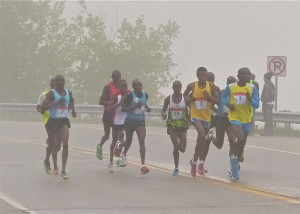
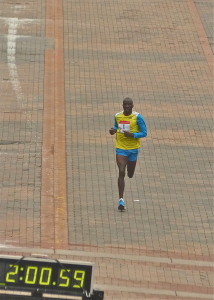
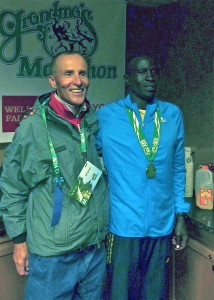
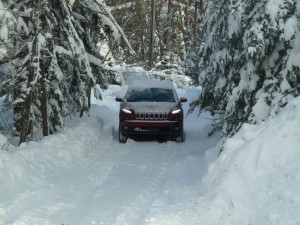

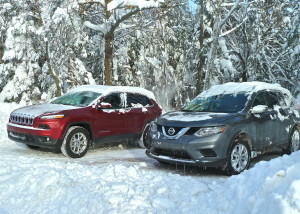
 John Gilbert is a lifetime Minnesotan and career journalist, specializing in cars and sports during and since spending 30 years at the Minneapolis Tribune, now the Star Tribune. More recently, he has continued translating the high-tech world of autos and sharing his passionate insights as a freelance writer/photographer/broadcaster. A member of the prestigious North American Car and Truck of the Year jury since 1993. John can be heard Monday-Friday from 9-11am on 610 KDAL(www.kdal610.com) on the "John Gilbert Show," and writes a column in the Duluth Reader.
John Gilbert is a lifetime Minnesotan and career journalist, specializing in cars and sports during and since spending 30 years at the Minneapolis Tribune, now the Star Tribune. More recently, he has continued translating the high-tech world of autos and sharing his passionate insights as a freelance writer/photographer/broadcaster. A member of the prestigious North American Car and Truck of the Year jury since 1993. John can be heard Monday-Friday from 9-11am on 610 KDAL(www.kdal610.com) on the "John Gilbert Show," and writes a column in the Duluth Reader.